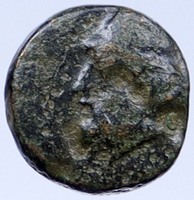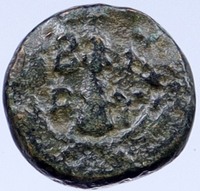Greek city of Birytis in Troas
Bronze 12mm (1.38 grams) Struck circa 300 B.C.
Reference: Sear 4057; B.M.C. 17.40,4
Bearded head of Kabeiros left, wearing conical pilos.
Club; B-I/P-Y in field; all within laurel-wreath. Nothing is known of the site and history of this town. You are bidding on the exact item pictured, provided with a Certificate of Authenticity and Lifetime Guarantee of Authenticity.
In Greek mythology, the Cabeiri, (Cabiri, Kabeiroi, Kabiri or Greek: Κάβειροι) were a group of enigmatic chthonic deities. They were worshiped in a mystery cult closely associated with that of Hephaestus, centered in the north Aegean islands of Lemnos and possibly Samothrace -at the Samothrace temple complex- and at Thebes. In their distant origins the Cabeiri and the Samothracian gods may include pre-Greek elements Hittite, Thracian, proto-Etruscan, or Phrygian elements. The Lemnian cult was always local to Lemnos, but the Samothracian mystery cult spread rapidly throughout the Greek world during the Hellenistic period, eventually initiating Romans. The ancient sources disagree about whether the deities of Samothrace were Cabeiri or not; and the accounts of the two cults differ in detail. But the two islands are close to each other, at the northern end of the Aegean, and the cults are at least similar, and neither fits easily into the Olympic pantheon: the Cabeiri were given a mythic genealogy as sons of Hephaestus. The accounts of the Samothracian gods, whose names were secret, vary in the number and sexes of the gods, usually between two and four, some of either sex. The number of Cabeiri also varied, with some accounts citing four (often a pair of males and a pair of females) of them, and some even more, such as a tribe or whole race of Cabeiri, often presented as all male. The Cabeiri were also worshipped at other sites in the vicinity, including Seuthopolis in Thrace and various sites in Asia Minor.
 The pileus (Greek πῖλος - pilos, also pilleus or pilleum in Latin) was a brimless, felt cap worn in Ancient Greece and surrounding regions, later also introduced in Ancient Rome. The Greek πιλίδιον (pilidion) and Latin pilleolus were smaller versions, similar to a skullcap. The pileus (Greek πῖλος - pilos, also pilleus or pilleum in Latin) was a brimless, felt cap worn in Ancient Greece and surrounding regions, later also introduced in Ancient Rome. The Greek πιλίδιον (pilidion) and Latin pilleolus were smaller versions, similar to a skullcap.
The pileus was especially associated with the manumission of slaves. who wore it upon their liberation. It became emblematic of liberty and freedom from bondage. During the classic revival of the 18th and 19th centuries it was widely confused with the Phrygian cap which, in turn, appeared frequently on statuary and heraldic devices as a "liberty cap."
 The Troad or Troas is the historical name of the Biga Peninsula (modern Turkish: Biga Yarımadası, Ancient Greek: Τρῳάς) in the northwestern part of Anatolia, Turkey. This region now is part of the Çanakkale province of Turkey. Bounded by the Dardanelles to the northwest, by the Aegean Sea to the west and separated from the rest of Anatolia by the massif that forms Mount Ida, the Troad is drained by two main rivers, the Scamander (Karamenderes) and the Simois, which join at the area containing the ruins of Troy. The Troad or Troas is the historical name of the Biga Peninsula (modern Turkish: Biga Yarımadası, Ancient Greek: Τρῳάς) in the northwestern part of Anatolia, Turkey. This region now is part of the Çanakkale province of Turkey. Bounded by the Dardanelles to the northwest, by the Aegean Sea to the west and separated from the rest of Anatolia by the massif that forms Mount Ida, the Troad is drained by two main rivers, the Scamander (Karamenderes) and the Simois, which join at the area containing the ruins of Troy.
Mount Ida, called by Homer "many-fountain" (πολυπίδαξ), sourced several rivers, including Rhesos, Heptaporos, Karesos, Rhodios, Grenikos (Granikos), Aesepos, Skamandros and Simoeis [Iliad 12.18 ff]; these rivers, were deified as a source of life by the Greeks, who depicted them on their coins as river-gods reclining by a stream and holding a reed. History The Troad gets its name from the Hittites' name for the region, Taruiša. This identification was first put forth by Emil Forrer, but largely disputed by most Hittite experts until 1983 when Houwink ten Cate showed that two fragments were from the same original cuneiform tablet and in his discussion of the restored letter showed that Taruiša and Wiluša (Troy) were correctly placed in northwestern Anatolia. According to Trevor Bryce, Hittite texts indicate a number of Ahhiyawan raids on Wilusa during the 13th century BC, which may have resulted in the overthrow of king Walmu. Bryce also said that archeological surveys conducted by John Bintliff in the 1970s showed that a powerful kingdom that held sway over northwestern Anatolia was based at Wilusa (Troy). Greek settlements flourished in Troas during the Archaic and Classical ages, as evidenced by the number of Greek poleis that coined money in their own names. The region was part of the satrapy (province) of Hellespontine Phrygia of the Achaemenid Empire. The Attalid kings of Pergamon (now Bergama) later ceded the territory of the Troad to the Roman Republic. Under the Roman Empire, the territory of the Troad became part of the province of Asia, and later of the smaller Mysian province Hellespontus; it was important enough to have suffragan bishoprics, including Pionia (now Avcılar). Under the later Byzantine Empire, it was included in the thema of the Aegean Islands. Following its conquest by the Ottoman Empire, the Troad formed part of the sanjak of Biga. New Testament The apostles Paul and Silas first visited Troas during their journey from Galatia to Macedonia. Paul also referred to Troas when he asked his fellow worker Timothy out of Ephesus, to bring the cloak he had left there, a journey of about 500 kilometres (310 mi). The changes from the story, being recounted as "they" to "we" in Acts 16 and Acts 20, imply that Paul was joined by Luke when he went through Troas. The region later known as the Troad was called Wilusa by the Hittites. This identification was first put forth by Emil Forrer, but largely disputed by most Hittite experts until 1983 when Houwink ten Cate showed that two fragments were from the same original cuneiform tablet and in his discussion of the restored letter showed that Wilusa was correctly placed in northwestern Anatolia. According to Trevor Bryce, Hittite texts indicate a number of Ahhiyawan raids on Wilusa during the 13th century BC, which may have resulted with the overthrow of king Walmu.
| 

 The pileus (Greek πῖλος - pilos, also pilleus or pilleum in Latin) was a brimless, felt cap worn in Ancient Greece and surrounding regions, later also introduced in Ancient Rome. The Greek πιλίδιον (pilidion) and Latin pilleolus were smaller versions, similar to a skullcap.
The pileus (Greek πῖλος - pilos, also pilleus or pilleum in Latin) was a brimless, felt cap worn in Ancient Greece and surrounding regions, later also introduced in Ancient Rome. The Greek πιλίδιον (pilidion) and Latin pilleolus were smaller versions, similar to a skullcap. The Troad or Troas is the historical name of the Biga Peninsula (modern Turkish: Biga Yarımadası, Ancient Greek: Τρῳάς) in the northwestern part of Anatolia, Turkey. This region now is part of the Çanakkale province of Turkey. Bounded by the Dardanelles to the northwest, by the Aegean Sea to the west and separated from the rest of Anatolia by the massif that forms Mount Ida, the Troad is drained by two main rivers, the Scamander (Karamenderes) and the Simois, which join at the area containing the ruins of Troy.
The Troad or Troas is the historical name of the Biga Peninsula (modern Turkish: Biga Yarımadası, Ancient Greek: Τρῳάς) in the northwestern part of Anatolia, Turkey. This region now is part of the Çanakkale province of Turkey. Bounded by the Dardanelles to the northwest, by the Aegean Sea to the west and separated from the rest of Anatolia by the massif that forms Mount Ida, the Troad is drained by two main rivers, the Scamander (Karamenderes) and the Simois, which join at the area containing the ruins of Troy.
